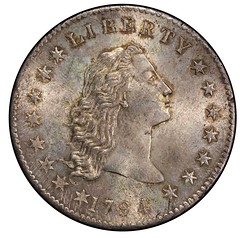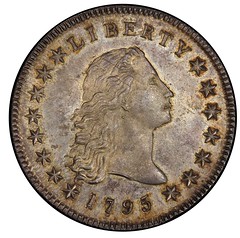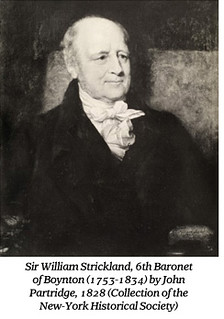
PREV ARTICLE
NEXT ARTICLE
FULL ISSUE
PREV FULL ISSUE
WILLIAM STRICKLAND'S 1794-1795 TRIP TO AMERICA
A great article by David Tripp has been published on the Stack's Bowers web site, part of the research into coins being offered in
the landmark Pogue collection. Here's an excerpt. In the article, David presents a convincing case for the pedigree of the famed
"Lord St. Oswald" coins. I especially encourage our younger subscribers to read and study this. Old dogs like me will have to
first unlearn things we thought we knew. It's an interesting story with intricate ties to America's Founding Fathers; be sure to
read the complete version online or in the Pogue II catalog. -Editor
Over the next three decades, an undocumented theory that an ancestor of the auction’s consignor, also named Major the Lord St. Oswald, M.C. (or Sir Rowland Winn), had acquired the coins at the Philadelphia Mint in the years of manufacture and that they had descended in the family found general, unquestioned, acceptance. In 1994, an article dismissed this hypothesis. It noted that there was no “Major the Lord St. Oswald, M.C.” in 1794-1795 (the title didn’t exist until 1885 nor, until 1914, did the military decoration, M.C. [Military Cross]). The article posited (based on correspondence with the then Lord St. Oswald [family name, Winn]) that no member of the Winn family had visited the United States in the 18th century, and that “It now appears certain the United States coins in the 1964 sale were not obtained directly from the Mint by a St. Oswald [Winn] family member.” However, new research, archival, numismatic, and genealogical, has produced a compelling body of circumstantial evidence that the St. Oswald coins were originally acquired by William Strickland (1753-1834), later 6th Baronet of Boynton. He paid a lengthy visit to the United States in 1794-1795, and was a member of the Winn family through which the coins descended until their sale. Strickland, a nephew of Sir Rowland Winn, 5th Baronet of Nostell (1739-1785), was a coin collector himself, and “actively expanded” both his father’s coin collection and library “rich in numismatic texts.” Following Strickland’s death in 1834, “[t]he coins duly made their way to Nostell.” They were acquired by Strickland’s son-in-law (and cousin) Charles Winn, from whom they passed to his son, Rowland Winn, later 1st Baron St. Oswald of Nostell (William Strickland’s grandson). William Strickland’s ten month tour of the United States in 1794-1795 was remarkable. Not only did he spend over four months in the nation’s capital, Philadelphia, but he had a wide circle of acquaintances in America’s governing circles; he knew a good number of the Founding Fathers socially, was a guest at both Mount Vernon and Monticello and became, upon his return to England, a correspondent of both George Washington and Thomas Jefferson.
The bulk of the lengthy article traces the history of the Strickland-Winn-St. Oswald Collections. -Editor
When William Strickland died in 1834, his coin collection (some of whose coins were accompanied by his own “very instructive” remarks) and portions of his library, notably the numismatic books, were acquired, at least in part by purchase (a balance paid of £166-10-0 was recorded in July 1836) by his son-in-law, Charles Winn, father of the 1st Baron St. Oswald of Nostell Priory. A close examination of the 1794-1795 Philadelphia Mint issues is even more revealing. The St. Oswald Collection only contained varieties or denominations that would have been available to William Strickland during his time in America between September 20, 1794, and July 29, 1795. The majority of the coins in effectively “new” condition were produced after October 15, 1794 and nearly half the collection’s 24 1794 large cents were from deliveries made while Strickland is known to have been in Philadelphia in December 1794. Bearing in mind that Strickland set sail for England on July 29, 1795, of particular interest is what 1795 coins the St. Oswald collection lacked: there were no examples of half eagles (first delivered July 31, 1795); no eagles (first delivered September 22, 1795); no Draped Bust dollars (first believed to have been produced around the beginning of October 1795); nor half cents or cents (which were not produced until the last two months of the year). The absence of 1795 half dimes, which theoretically he could have obtained is inexplicable, but for the majority of types and denominations produced in 1795 the St. Oswald collection is notably missing all the 1795-dated coins which were produced after William Strickland had left for home. Conclusion: That such an astonishing group of American coins produced at the Philadelphia Mint in 1794-1795, in near perfect condition, survived in the collection of a single family for over a century-and-a-half is, on its own, remarkable. But even more astonishing is that there is now demonstrable evidence that identifies which of their ancestors (a coin collector) toured the United States of America and was in Philadelphia in 1794-1795. The importance of the 1794-1795 coins from the William Strickland-Charles Winn-Lord St. Oswald-Nostell Priory Collection cannot be understated. They were originally acquired in the year of issue, not merely by some casual tourist, but by a truly remarkable man: a vitally interested amateur, a numismatist no less, who traveled in the august company of some of our nation’s Founding Fathers, including a number who were integral to the birth of the United States Mint. The original “Lord St. Oswald” theory, once discarded, may now be said to have been not so wide of the mark, and that with William Strickland as the original acquisitor, the provenance is even richer and more important than previously imagined. It was, very much, a family affair.
The article includes a reconstructed collection of United States Colonial, Post-Colonial, and Federal Coins removed from Nostell Priory
and sold to Christie’s in 1964 & 1992. Again, be sure to read the complete article, which also appears in the Pogue II catalog. Below are
images of two of the coins in the upcoming Pogue sale. -Editor
 
To read the complete article, see:
To read the complete lot descriptions, see:
THE BOOK BAZARREWayne Homren, Editor The Numismatic Bibliomania Society is a non-profit organization promoting numismatic literature. See our web site at coinbooks.org. To submit items for publication in The E-Sylum, write to the Editor at this address: whomren@gmail.com To subscribe go to: https://my.binhost.com/lists/listinfo/esylum All Rights Reserved. NBS Home Page Contact the NBS webmaster 
|
